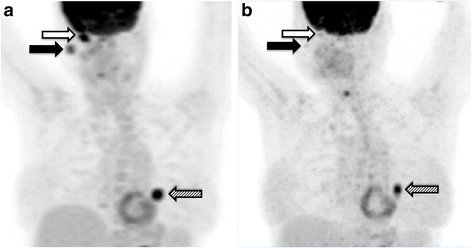A case report of a patient with metastatic ocular melanoma who experienced a response to treatment with the BRAF inhibitor vemurafenib
- PMID: 27520988
- PMCID: PMC4983009
- DOI: 10.1186/s12885-016-2657-7
A case report of a patient with metastatic ocular melanoma who experienced a response to treatment with the BRAF inhibitor vemurafenib
Abstract
Background: Conjunctival malignant melanoma (CMM) is a rare malignancy and in the advanced setting there is no effective treatment. In contrast, half of cutaneous melanomas have BRAF mutations and treatment with BRAF inhibitors is established for patients with disseminated disease. The most common form of ocular melanoma, uveal melanoma, lacks these mutations, however, their presence has been reported for CMM.
Case presentation: We used the BRAF inhibitor vemurafenib to treat a 53 year-old female suffering from a BRAF(V600E) mutated metastatic CMM. The patient benefited from the treatment, a response was evident within a week and she experienced a progression free survival of four months.
Conclusions: To our knowledge, this is the first described case of response to vemurafenib treatment in a patient with ocular melanoma.
Keywords: BRAF inhibitor; BRAF mutation; Conjunctival malignant melanoma; Ocular melanoma; Vemurafenib.
Figures


Similar articles
-
Vemurafenib in patients with BRAF(V600) mutated metastatic melanoma: an open-label, multicentre, safety study.Lancet Oncol. 2014 Apr;15(4):436-44. doi: 10.1016/S1470-2045(14)70051-8. Epub 2014 Feb 27. Lancet Oncol. 2014. PMID: 24582505 Clinical Trial.
-
Vemurafenib in patients with BRAF V600E mutation-positive advanced melanoma.Clin Ther. 2012 Jul;34(7):1474-86. doi: 10.1016/j.clinthera.2012.06.009. Epub 2012 Jun 27. Clin Ther. 2012. PMID: 22742884 Review.
-
The clinical response to vemurafenib in a patient with a rare BRAFV600DK601del mutation-positive melanoma.BMC Cancer. 2014 Sep 29;14:727. doi: 10.1186/1471-2407-14-727. BMC Cancer. 2014. PMID: 25265970 Free PMC article.
-
Quantitative cell-free circulating BRAFV600E mutation analysis by use of droplet digital PCR in the follow-up of patients with melanoma being treated with BRAF inhibitors.Clin Chem. 2015 Jan;61(1):297-304. doi: 10.1373/clinchem.2014.230235. Epub 2014 Nov 19. Clin Chem. 2015. PMID: 25411185
-
Vemurafenib for the treatment of locally advanced or metastatic BRAF V600 mutation-positive malignant melanoma: a NICE single technology appraisal.Pharmacoeconomics. 2013 Dec;31(12):1121-9. doi: 10.1007/s40273-013-0094-x. Pharmacoeconomics. 2013. PMID: 24114739 Review.
Cited by
-
Overexpression of EZH2 in conjunctival melanoma offers a new therapeutic target.J Pathol. 2018 Aug;245(4):433-444. doi: 10.1002/path.5094. Epub 2018 Jun 23. J Pathol. 2018. PMID: 29732557 Free PMC article.
-
Current findings of genetic alterations and associated targeted therapies of conjunctival melanocytic neoplasms.Taiwan J Ophthalmol. 2025 Mar 6;15(1):26-33. doi: 10.4103/tjo.TJO-D-24-00109. eCollection 2025 Jan-Mar. Taiwan J Ophthalmol. 2025. PMID: 40213303 Free PMC article. Review.
-
New Therapeutic Approaches for Conjunctival Melanoma-What We Know So Far and Where Therapy Is Potentially Heading: Focus on Lymphatic Vessels and Dendritic Cells.Int J Mol Sci. 2022 Jan 27;23(3):1478. doi: 10.3390/ijms23031478. Int J Mol Sci. 2022. PMID: 35163401 Free PMC article. Review.
-
Dabrafenib and Trametinib for BRAF-Mutated Conjunctival Melanoma.Ocul Oncol Pathol. 2020 Jan;6(1):35-38. doi: 10.1159/000497473. Epub 2019 Jul 26. Ocul Oncol Pathol. 2020. PMID: 32002403 Free PMC article.
-
Conjunctival melanoma.An Bras Dermatol. 2018 Nov/Dec;93(6):936-937. doi: 10.1590/abd1806-4841.20187657. An Bras Dermatol. 2018. PMID: 30484552 Free PMC article. No abstract available.
References
-
- Brownstein S. Malignant melanoma of the conjunctiva. Cancer Control. 2004;11(5):310–316. - PubMed
Publication types
MeSH terms
Substances
LinkOut - more resources
Full Text Sources
Other Literature Sources
Medical
Research Materials

